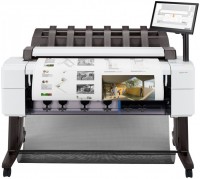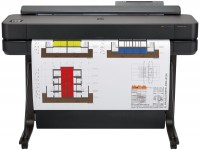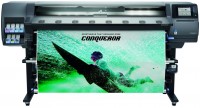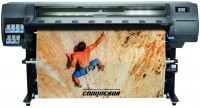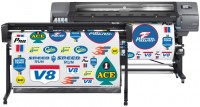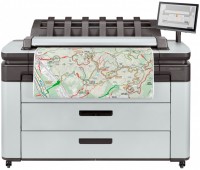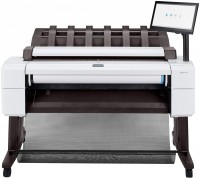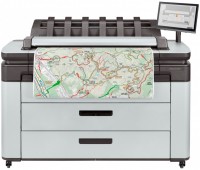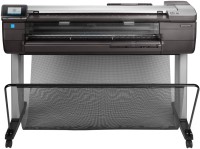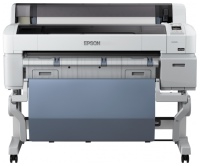Plotter Printers HP
All Plotter Printers Advanced filters → |
You might be interested in
Plotter Printers: specifications, types
Product Type
The type of plotter is indicated by the technology used for printing. Nowadays, laser and inkjet models are most widely used, but other, more specific varieties can be found — solvent, sublimation, ultraviolet, textile, latex and solid ink plotters. Here are the main features of each of these types:
— Inkjet. In inkjet plotters, the image is built from the smallest drops of ink, “spit out” by the print head onto the paper. Such devices are relatively inexpensive, while they provide good print quality and can work with plain paper, and the inkjet technology itself is suitable for full-colour images. One of its key cons can be called poor suitability for making numerous prints in a short time: printing is relatively slow, and prints are more expensive than, for example, laser ones. In addition, the ink used for classical inkjet printing is sensitive to humidity, temperature changes and, in most cases, ultraviolet light. Therefore, materials printed on such a plotter are only suitable for indoor use; for outdoor installations, either protective coatings or more sustainable technology such as UV or solvent (see below) should be used.
— Laser. Laser printing is carried out using powdered toner: the laser beam "marks" individual areas on a special light-sensitive drum, toner sticks to these areas, which is then transferred to paper. Such devices are very convenient for operating with numerous materials: printing is fast, and the cost of one print is low. On the other hand, the vast majority of such plotters are monochrome, for drawings and other similar materials. For colour printing, laser technology is poorly suited. Laser plotters are expensive. However, relatively recently, a specific variety has appeared — LED-plotters. They are similar in principle of operation, which is why they are also commonly referred to as laser ones; however, instead of a single emitter, such devices use a system of LEDs. This made it possible to simplify the design and reduce its cost.
— Solvent. This printing technology is generally similar to inkjet, but it uses a special ink based on solvent — a solvent obtained from petroleum products. The advantage of such inks over common inks is that the solvent "penetrates" deeply into the surface of the material. This ensures reliability, resistance to adverse conditions, as well as the ability to print on a wide variety of materials — banners, vinyl films, fabrics, etc. At the same time, unlike UV printing, the materials do not require special processing — it is enough to wait for the solvent to dry. Thanks to all this, as well as the ability to create a colorful image, solvent plotters are very popular, in particular, in the production of outdoor advertising. However, this technology has its cons — foremost, a pungent smell, which makes it difficult to print materials for internal use.
— Sublimation. Plotters, which action is based on the phenomenon of sublimation — the evaporation of a solid dye and the settling of its particles on the media (often under the surface of the media). There are two types of sublimation printing: direct, when the image is applied directly to the final media, and transfer, when the image is printed on a transitional carrier and transferred from it to the media surface using a heat press. In modern plotters, the second option is most often found — it allows you to print on a wide variety of materials, including voluminous objects that simply would not fit in a plotter. This way of plotter operating that are meant in this case by the term “sublimation”, and devices with the possibility of direct printing are highlighted in a separate category — textile; see below for more details. Anyway, sublimation technology provides a higher quality image than inkjet (and its analogues), however, the ink is sensitive to ultraviolet light, which may require the use of protective coatings.
— Ultraviolet. A variation of inkjet printing (see above), using the so-called UV-ink – an ink that solidify when exposed to UV light. Such ink forms a film on the surface of the printed media that protects the applied image from adverse influences (dust, humidity); At the same time, due to the good adhesive properties of the ink, a wide variety of materials can be used for printing, which makes this technology well suited for outdoor advertising. Compared to another similar technology — solvent — UV inks are more expensive, but for a number of reasons, prints are somewhat cheaper. Other pros include instant solidification and less expressed odour, making UV printing suitable for indoor materials as well.
— Textile. Plotters with the ability to print on fabrics. Usually, they are a kind of sublimation models (see above), which support the possibility of direct printing. Note that a durable and stable image with such printing can only be obtained on synthetics — the ink is gradually washed off from cotton and other natural fabrics during washing. In addition, this method is not suitable for materials sensitive to heat.
— Solid ink. As the name suggests, this type of plotter uses solid state dyes to print. When printing, the required portions of ink are melted and applied to the drum, which prints them onto the media. Solid ink devices are compatible with a wide variety of materials (paper, film, cardboard), they provide bright, rich colour images with excellent resolution, provide good speed, and the cost of prints over long periods of use is very low. Among the cons of this technology, is the necessary to constantly keep the plotter turned on — otherwise, each time it is turned on, part of the ink will be dumped into the waste container.
— Latex. Plotters using water-based ink with the addition of synthetic latex. During operation, individual dots are applied similarly to inkjet printing (see above), after which they are heated with an oven to evaporate water and holding the latex. One of the key advantages of this type of plotters is environmental friendliness: they are safe and can be installed in any room. In addition, latex plotters are compatible with a wide range of materials (including even textiles), provide good brightness and colour reproduction, and prints are odorless and resistant to moisture.
— Inkjet. In inkjet plotters, the image is built from the smallest drops of ink, “spit out” by the print head onto the paper. Such devices are relatively inexpensive, while they provide good print quality and can work with plain paper, and the inkjet technology itself is suitable for full-colour images. One of its key cons can be called poor suitability for making numerous prints in a short time: printing is relatively slow, and prints are more expensive than, for example, laser ones. In addition, the ink used for classical inkjet printing is sensitive to humidity, temperature changes and, in most cases, ultraviolet light. Therefore, materials printed on such a plotter are only suitable for indoor use; for outdoor installations, either protective coatings or more sustainable technology such as UV or solvent (see below) should be used.
— Laser. Laser printing is carried out using powdered toner: the laser beam "marks" individual areas on a special light-sensitive drum, toner sticks to these areas, which is then transferred to paper. Such devices are very convenient for operating with numerous materials: printing is fast, and the cost of one print is low. On the other hand, the vast majority of such plotters are monochrome, for drawings and other similar materials. For colour printing, laser technology is poorly suited. Laser plotters are expensive. However, relatively recently, a specific variety has appeared — LED-plotters. They are similar in principle of operation, which is why they are also commonly referred to as laser ones; however, instead of a single emitter, such devices use a system of LEDs. This made it possible to simplify the design and reduce its cost.
— Solvent. This printing technology is generally similar to inkjet, but it uses a special ink based on solvent — a solvent obtained from petroleum products. The advantage of such inks over common inks is that the solvent "penetrates" deeply into the surface of the material. This ensures reliability, resistance to adverse conditions, as well as the ability to print on a wide variety of materials — banners, vinyl films, fabrics, etc. At the same time, unlike UV printing, the materials do not require special processing — it is enough to wait for the solvent to dry. Thanks to all this, as well as the ability to create a colorful image, solvent plotters are very popular, in particular, in the production of outdoor advertising. However, this technology has its cons — foremost, a pungent smell, which makes it difficult to print materials for internal use.
— Sublimation. Plotters, which action is based on the phenomenon of sublimation — the evaporation of a solid dye and the settling of its particles on the media (often under the surface of the media). There are two types of sublimation printing: direct, when the image is applied directly to the final media, and transfer, when the image is printed on a transitional carrier and transferred from it to the media surface using a heat press. In modern plotters, the second option is most often found — it allows you to print on a wide variety of materials, including voluminous objects that simply would not fit in a plotter. This way of plotter operating that are meant in this case by the term “sublimation”, and devices with the possibility of direct printing are highlighted in a separate category — textile; see below for more details. Anyway, sublimation technology provides a higher quality image than inkjet (and its analogues), however, the ink is sensitive to ultraviolet light, which may require the use of protective coatings.
— Ultraviolet. A variation of inkjet printing (see above), using the so-called UV-ink – an ink that solidify when exposed to UV light. Such ink forms a film on the surface of the printed media that protects the applied image from adverse influences (dust, humidity); At the same time, due to the good adhesive properties of the ink, a wide variety of materials can be used for printing, which makes this technology well suited for outdoor advertising. Compared to another similar technology — solvent — UV inks are more expensive, but for a number of reasons, prints are somewhat cheaper. Other pros include instant solidification and less expressed odour, making UV printing suitable for indoor materials as well.
— Textile. Plotters with the ability to print on fabrics. Usually, they are a kind of sublimation models (see above), which support the possibility of direct printing. Note that a durable and stable image with such printing can only be obtained on synthetics — the ink is gradually washed off from cotton and other natural fabrics during washing. In addition, this method is not suitable for materials sensitive to heat.
— Solid ink. As the name suggests, this type of plotter uses solid state dyes to print. When printing, the required portions of ink are melted and applied to the drum, which prints them onto the media. Solid ink devices are compatible with a wide variety of materials (paper, film, cardboard), they provide bright, rich colour images with excellent resolution, provide good speed, and the cost of prints over long periods of use is very low. Among the cons of this technology, is the necessary to constantly keep the plotter turned on — otherwise, each time it is turned on, part of the ink will be dumped into the waste container.
— Latex. Plotters using water-based ink with the addition of synthetic latex. During operation, individual dots are applied similarly to inkjet printing (see above), after which they are heated with an oven to evaporate water and holding the latex. One of the key advantages of this type of plotters is environmental friendliness: they are safe and can be installed in any room. In addition, latex plotters are compatible with a wide range of materials (including even textiles), provide good brightness and colour reproduction, and prints are odorless and resistant to moisture.
Paper size
The paper size the plotter is designed to operate with. Most models use ISO 216 formats, identified by the letter A followed by a digit. These formats include the popular A4, but plotters usually work with larger paper:
- A0+. This marking means that the plotter is able to work with sheets larger than A0 (see below). The A0+ format itself provides a sheet width of 914 mm, however, in this case, support for wider media is usually provided — about 1100 mm (1050 – 1150 mm) in the most modest m...odels of this format ( A0+ 44 ") and 1500 mm or more in the largest ( A0+ ≥ 60")
- A0. Paper of this format has a size of 1189x841 mm.
- A1. Paper size 841x594 mm — in other words, half of the A0 format.
- A2. A sheet of this format is approximately the size of a newspaper spread — 420x594 mm, half the size of A1. Considered relatively small by plotter standards.
- A3. The smallest format found in modern plotters: 297x420 mm, that is, only twice the standard A4 (in other words, with a magazine spread). Used in few desktop models (see Installation) — particularly, textile devices (see Product Type) for printing on T-shirts and other similarly sized clothes.
Output Type
Colour plotter — the range of colours reproduced by the unit when printing.
— Coloured. Devices that use the entire colour gamut. Such printing is more expensive than black and white, but it allows you to get bright and most reliable images; of course, if necessary, a monochrome image can also be reproduced on such a plotter. So, this option is most popular nowadays. Technically, almost any printing technology can be used in colour devices (see "Prod...uct Type") — except that laser colour printing is too complicated and expensive, and therefore usually does not occur in plotters.
— Monochrome. The common name for such devices is “black and white,” since monochrome plotters print exactly in black (to be precise, in different shades of grey). Obviously, the possibilities of such printing are very limited compared to colour. However, it also has a number of advantages — in particular, it allows the use of laser technology, thus providing a very low cost per print and high speed. In addition, for some tasks — for example, printing drawings — colour is not initially required. Actually, plotters from this category are used mainly for operating with large-format drawings.
— Coloured. Devices that use the entire colour gamut. Such printing is more expensive than black and white, but it allows you to get bright and most reliable images; of course, if necessary, a monochrome image can also be reproduced on such a plotter. So, this option is most popular nowadays. Technically, almost any printing technology can be used in colour devices (see "Prod...uct Type") — except that laser colour printing is too complicated and expensive, and therefore usually does not occur in plotters.
— Monochrome. The common name for such devices is “black and white,” since monochrome plotters print exactly in black (to be precise, in different shades of grey). Obviously, the possibilities of such printing are very limited compared to colour. However, it also has a number of advantages — in particular, it allows the use of laser technology, thus providing a very low cost per print and high speed. In addition, for some tasks — for example, printing drawings — colour is not initially required. Actually, plotters from this category are used mainly for operating with large-format drawings.
Placement
- Floor. Plotters designed for installation directly on the floor, on special stands; the availability of a stand for such a device is mandatory, because it carries various auxiliary equipment – particularly, a basket for completed prints. The floor models are predominantly advanced models, which are distinguished by their large weight and size. This option is convenient because the plotter does not require additional surfaces such as tables for installation. On...the other hand, such a unit can create inconvenience in tight room where there is little free space on the floor. Also note that some floor models are not equipped with stands, they must be purchased separately.
- Desktop. Plotters designed to be placed on a table, workbench, or other similar stand. This installation is good in constrained conditions, because it does not require floor space. On the other hand, it imposes some restrictions on weight and dimensions, which is why desktop plotters are usually designed for relatively small paper sizes - A2, less often A1 (see above).
- Desktop. Plotters designed to be placed on a table, workbench, or other similar stand. This installation is good in constrained conditions, because it does not require floor space. On the other hand, it imposes some restrictions on weight and dimensions, which is why desktop plotters are usually designed for relatively small paper sizes - A2, less often A1 (see above).
Scanner
The presence of a built-in scanner in the plotter.
This function actually turns the plotter into an MFP (multifunctional device): the scanner allows you to digitize printed materials, as well as use the unit as a copier (however, this possibility should be specified separately). At the same time, built-in scanners, like the plotters themselves, are usually designed for large-format media. In addition, such equipment can be combined with various addit...ional features — in particular, some devices with a scanner can not only send digitized materials to a PC, but also save them to a flash drive or memory card, and even send them to e-mail, network storage or an Internet resource.
This function actually turns the plotter into an MFP (multifunctional device): the scanner allows you to digitize printed materials, as well as use the unit as a copier (however, this possibility should be specified separately). At the same time, built-in scanners, like the plotters themselves, are usually designed for large-format media. In addition, such equipment can be combined with various addit...ional features — in particular, some devices with a scanner can not only send digitized materials to a PC, but also save them to a flash drive or memory card, and even send them to e-mail, network storage or an Internet resource.
Max resolution
The highest image resolution the plotter is capable of printing on paper. It is indicated by the number of dots per inch horizontally and vertically — for example, 1440x720.
The higher the resolution, the smoother the printed image will be as a result, the less noticeable individual dots will be on it (to the point that they cannot be seen at all with the naked eye). On the other hand, the ability to print in such resolutions affects the price of the plotter accordingly. In addition,...do not forget that high-quality printing requires appropriate source materials — the quality of the print cannot be higher than the quality of the original image.
Note that in this case we are talking about the maximum resolution; usually in the settings it is possible to set more modest parameters.
The higher the resolution, the smoother the printed image will be as a result, the less noticeable individual dots will be on it (to the point that they cannot be seen at all with the naked eye). On the other hand, the ability to print in such resolutions affects the price of the plotter accordingly. In addition,...do not forget that high-quality printing requires appropriate source materials — the quality of the print cannot be higher than the quality of the original image.
Note that in this case we are talking about the maximum resolution; usually in the settings it is possible to set more modest parameters.



